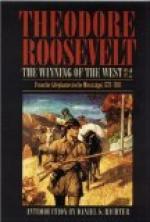Boon accepted the proposition, but, being suspicious of the good-faith of his opponents, insisted upon the conference being held within sixty yards of the fort. After the treaty was concluded the Indians proposed to shake hands with the nine white treaty-makers, and promptly grappled them. [Footnote: Apparently there were eighteen Indians on the treaty ground, but these were probably, like the whites, unarmed.] However, the borderers wrested themselves free, and fled to the fort under a heavy fire, which wounded one of their number.
The Indians then attacked the fort, surrounding it on every side and keeping up a constant fire at the loop-holes. The whites replied in kind, but the combatants were so well covered that little damage was done. At night the Indians pitched torches of cane and hickory bark against the stockade, in the vain effort to set it on fire, [Footnote: McAfee MSS.] and de Quindre tried to undermine the walls, starting from the water mark. But Boon discovered the attempt, and sunk a trench as a countermine. Then de Quindre gave up and retreated on August 20th, after nine days’ fighting, in which the whites had but two killed and four wounded; nor was the loss of the Indians much heavier. [Footnote: De Quindre reported to Hamilton that, though foiled, he had but two men killed and three wounded. In Haldimand MSS., Hamilton to Haldimand, October 15, 1778. Often, however, these partisan leaders merely reported the loss in their own particular party of savages, taking no account of the losses in the other bands that had joined them—as the Miamis joined the Shawnees in this instance. But it is certain that Boon (or Filson, who really wrote the Narrative) greatly exaggerated the facts in stating that thirty-seven Indians were killed, and that the settlers picked up 125 pounds’ weight of bullets which had been fired into the fort.]
This was the last siege of Boonsborough. Had de Quindre succeeded he might very probably have swept the whites from Kentucky; but he failed, and Boon’s successful resistance, taken together with the outcome of Clark’s operations at the same time, ensured the permanency of the American occupation. The old-settled region lying around the original stations, or forts, was never afterwards seriously endangered by Indian invasion.




